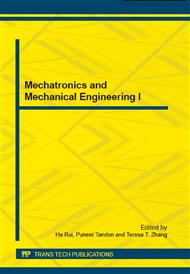[1]
P. Besl and N. McKay: A method for registration of 3-D shapes, IEEE Trans. Pattern Anal. Machine Intell. Vol. 14(2), 1992, p.239–256.
DOI: 10.1109/34.121791
Google Scholar
[2]
Y. Chen and G. Medioni: Object modelling by registration of multiple range images, , Image and vision computing. Vol. 10(3), 1992, pp.145-155.
DOI: 10.1016/0262-8856(92)90066-c
Google Scholar
[3]
M. Magnusson, A. Lilienthal and T. Duckett: Scan registration for autonomous mining vehicles using 3D-NDT, Journal of Field Robotics. Vol. 24(10), 2007, pp.803-827.
DOI: 10.1002/rob.20204
Google Scholar
[4]
S. Rusinkiewicz and M. Levoy: Efficient variants of the ICP algorithm, In Third International Conference on 3D Digital Imaging and Modeling, 2001, pp.145-152.
DOI: 10.1109/im.2001.924423
Google Scholar
[5]
R. Rusu, N. Blodow and M. Beetz: Fast point feature histograms (FPFH) for 3D registration, , IEEE International Conference on Robotics and Automation (ICRA), 2009, pp.3212-3217.
DOI: 10.1109/robot.2009.5152473
Google Scholar
[6]
A. Johnson, Spin-Images: A representation for 3-D surface matching, Ph.D. dissertation, Robotics Institute, Carnegie Mellon University, Pittsburgh, PA, (1997).
Google Scholar
[7]
B. Steder, R. B. Rusu, K. Konolige and W. Burgard: NARF: 3D range image features for object recognition, , in Workshop on Defining and Solving Realistic Perception Problems in Personal Robotics at the IEEE/RSJ Int. Conf. on Intelligent Robots and Systems (IROS), (2010).
DOI: 10.1109/icra.2011.5980187
Google Scholar
[8]
A. Frome, D. Huber, R. Kolluri, T. Blow, and J. Malik: Recognizing objects in range data using regional point descriptors, , Proceedings of the European Conference on Computer Vision (ECCV), 2004, pp.356-369.
DOI: 10.1007/978-3-540-24672-5_18
Google Scholar
[9]
Zhang, L.: Line Primitives and Their Applications in Geometric Computer Vision, Universitätsbibliothek Kiel, (2013).
Google Scholar
[10]
Xiao, J.: Planar Segments Based Three-dimensional Robotic Mapping in Outdoor Environments, (2013).
Google Scholar
[11]
C. Tongtong, D. Bin, L. Daxue, Z. Bo and L. Qixu: 3d lidar-based ground segmentation, in 2011 First Asian Conference on Pattern Recognition (ACPR), Beijing, China, 2011, p.446–450.
DOI: 10.1109/acpr.2011.6166587
Google Scholar
[12]
B. Douillard, J. Underwood, N. Kuntz, V. Vlaskine, A. Quadros, P. Morton, and A. Frenkel, On the segmentation of 3d lidar point clouds, IEEE International Conference on Robotics and Automation (ICRA), Shanghai, China, May 2011, p.2798–2805.
DOI: 10.1109/icra.2011.5979818
Google Scholar
[13]
T. Foley and J. Sugerman: KD-tree acceleration structures for a GPU raytracer, In Proceedings of the ACM SIGGRAPH/EUROGRAPHICS conference on Graphics hardware, 2005, pp.15-22.
DOI: 10.1145/1071866.1071869
Google Scholar
[14]
Kalman, R.E.: A new approach to linear filtering and prediction problems, , Journal of basic Engineering, Vol. 82(1), 1960, pp.35-45.
DOI: 10.1115/1.3662552
Google Scholar


